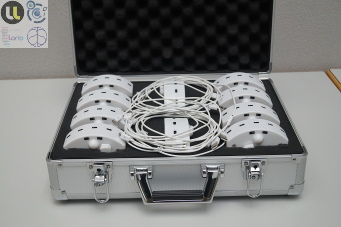(I translated the previous article, as most of the pages on wich I added a reference to it were in French.)
Cette page est référencée par la liste des portable HP testés sous Ubuntu, et sur la liste des cartes Wi-Fi fonctionnant sous Ubuntu et celle des matériels bluetooth pris en charge…
L’installation de ce portable comporte deux points techniques : la gestion de la carte carte combo wifi/bluetooth Realtek RTL8723DE, et la configuration de VMware pour utiliser le système Windows installé en dual-boot.
Activer le Wi-Fi et le bluetooth
Le portable HP 14-cf0013nf contient une carte mère Intel® Core™ i3-7020U avec une carte graphique HD Graphics 620. Les deux sont parfaitement reconnues par XUbuntu 18.04. Ce n’est cependant pas le cas pour la carte combo wifi/bluetooth Realtek RTL8723DE : elle a besoin de quelques manipulations pour fonctionner correctement !
J’ai trouvé deux solutions pour faire fonctionner le Wi-Fi (Network Manager ne montre à l’origine aucun réseau Wi-Fi, car le module du noyau ne gère pas correctement la carte RTL8723DE) :
- La solution la plus souvent recommandée (y compris par HP – en anglais) est d’utiliser la branche extended du dépôt GitHub rtlwifi_new de Larry Finger. Vous pouvez soit récupérer l’archive sur la page, soit utiliser git ou svn pour télécharger le code.
Vous pouvez alors soit compiler et installer ce code (make; sudo make install), soit utiliser dkms pour le faire (sudo dkms add ./rtlwifi_new; sudo dkms install rtlwifi-new/0.6). La seconde solution est préférable, car le module devrait être automatiquement recompilé pour tout nouveau noyau (si j’ai bien compris). Vous aurez besoin d’installer le paquet build-essential, ainsi que dkms (en anglais) pour la seconde solution.
Vous pouvez alors utiliser ce module avec sudo modprobe -v rtl8723de ant_sel=1, le dernier argument indiquant quelle antenne vous voulez utiliser (1 ou 2,testez les deux pour trouver celle qui fonctionne le mieux). Attention : cette solution n’est pas efficace pour mon portable, le signal Wi-Fi étant plus faible (entre 50 et 60 %) que sous Windows avec le même portable, ou sous Xubuntu avec d’autres.
- En cherchant un moyen d’avoir un meilleur signal, j’ai trouvé dans un des problèmes (en anglais) du dépôt de Larry Finger une référence à un module de smlinux, qui est plus récent.
J’ai commencé par enlever l’autre module: sudo service NetworkManager stop; sudo rmmod -f rtl8723_common rtl8723de; sudo dkms uninstall rtlwifi-new/0.6; sudo dkms remove rtlwifi-new/0.6 --all; sudo service NetworkManager start.
Comme ci-dessus, vous pouvez récupérer l’archive or télécharger le code, puis compiler et installer ce code (make; sudo make install) or utiliser dkms (sudo dkms add ./rtl8723de; sudo dkms install rtl8723de/5.1.1.8_21285.20171026_COEX20170111-1414). Une fois le module lancé (toujours avec sudo modprobe -v rtl8723de ant_sel=#), le signal Wi-Fi est bien meilleur (similaire à Windows ou à un autre portable)!
Pour les deux solutions, le Secure Boot doit être désactivé, ou le module n’est pas démarré (et vous n’avez de nouveau aucune connexion Wi-Fi dans Network Manager). Cela peut (c’était mon cas) changer l’ordre des Boot Loaders, mettant en premier celui de MS (qui démarre Windows) au lieu du grub (qui donne le choix). Il faut alors remettre le bon ordre dans les réglages du Bios.
Il est dommage qu’aucun de ces deux modules ne soit proposé d’une manière plus simple, comme le module de Dmitry Tunin (pointé dans la liste des portable HP testés sous Ubuntu) qui est disponible sous la forme d’un paquet : sudo add-apt-repository ppa:hanipouspilot/rtlwifi; sudo apt-get update; sudo apt-get install rtlwifi-new-dkms; echo "options rtl8723be fwlps=1 ips=0 ant_sel=2" | sudo tee /etc/modprobe.d/rtl8723be.conf. C’est plus simple à installer, mais ce module ne concerne pas la carte RTL8723DE, mais la RTL8723BE et d’autres.
Faire fonctionner le bluetooth a été plus simple, grace à Dmitry Tunin ! Encore une fois, le module par défaut n’était pas le bon : blueman ne disposait d’aucun adaptateur. Une discussion effrayante (en anglais) se termine heureusement par une réponse rassurante : il suffit de quelques commandes (sudo add-apt-repository ppa:hanipouspilot/bluetooth; sudo apt update; sudo apt install btrtl-rtl8723de-dkms) pour faire fonctionner le bluetooth !
Configurer VMware pour utiliser le système du disque
Bientôt !






